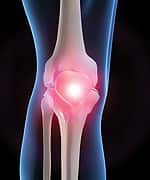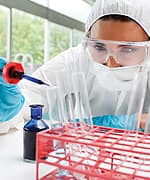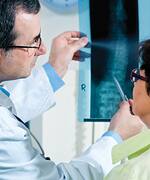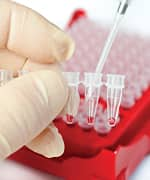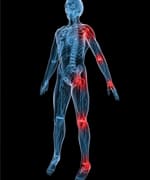Life Extension Magazine®
By the time people reach age 65, a startling 80% show X-ray evidence of osteoarthritis1—the most frequent cause of musculo-skeletal disability worldwide.1,2 Most doctors consider osteoarthritis and rheumatoid arthritis to be progressive and incurable. Side effect prone drugs only transiently soften pain and have no long-term impact on the disease itself.3,4 Conventional medical wisdom mistakenly believed that in contrast to rheumatoid arthritis—which results from an autoimmune attack on joints—osteoarthritis was simply the result of age-related “wear-and-tear.” However, scientists now understand that, in both of these conditions, an inflammatory immune system attack on joint compounds can be triggered by exposed collagen.5 This article is about undenatured type II collagen, which has a unique molecular structure that interferes with damaging inflammation responses and helps to retrain the immune system. Studies show that exposure to small amounts of type II chicken collagen can inhibit immune overreaction to exposed collagen proteins, substantially reducing the pain and disability of osteoarthritis4,6-8 and rheumatoid arthritis.9-12 In one study, an unheard-of 14% of patients taking undenatured type II collagen experienced complete remission of their rheumatoid arthritis!9 A unique formulation of undenatured type II collagen, UC-II®, was found in controlled studies to significantly reduce pain and increase function in arthritic dogs,6,7,13,14 horses,8 and humans.4 As you’ll learn, pain scores for osteoarthritis patients taking UC-II® decreased—in just 90 days—by a remarkable 40%!4 A New Understanding of Osteoarthritis
Cartilage, the shock-absorbing substance that lines our joints and allows them to slide smoothly, is comprised largely of a protein known as collagen. Minor damage to cartilage exposes small fibers of collagen that trigger rheumatoid arthritis—and osteoarthritis as well. Until recently, conventional medical thinking held that these two forms of arthritis involve different pathologies. Only rheumatoid arthritis was recognized as an inflammatory immune process—where the body’s oversensitive immune system attacks the body’s own tissues, in this case the joint linings and cartilage. By contrast, osteoarthritis was believed to be an unavoidable result of the simple wear-and-tear of age and repeated use on joint cartilage and bone. It was assumed that joint-cushioning cartilage simply wore away, leaving the friction of increasingly painful scraping and inflammation. The assumption that osteoarthritis is the degeneration of cartilage may have stemmed largely from the fact that this form of arthritis arises typically in the later years of life; and the number of minor cartilage traumas that can spark an immune response tend to increase as the water content of cartilage is reduced—which is indeed, age-related. So, osteoarthritis has long been assumed to be an inevitable and incurable consequence of aging. In recent years, research has increasingly shown that immune mediated joint inflammation plays a large role in the development and perpetuation of osteoarthritis. This new understanding of the underlying cause of osteoarthritis offers new avenues for medical intervention and has even brought forth the possibility of a cure! New research shows that the underlying pathology behind osteoarthritis is the triggering of an inflammatory immune response—similar to rheumatoid arthritis. The end result—for both forms of arthritis, scientists now realize—is activation of “killer” T-cells by exposed collagen, destruction of joint surfaces, and the accompanying pain and impaired function.9,15 For the first time, this establishes osteoarthritis as a disease progression that is not inevitable—and opens the door to the possibility of a single intervention to modulate the abnormal immune response behind both of these types of arthritis. So let’s take a look at how scientists now see the development of osteoarthritis, and how we can re-educate the immune system to halt the progression of both types of arthritis—and reverse it! The Immune System Cause of Joint DiseaseJoints take a beating over time, with those in the weight-bearing lower half of our bodies taking the heaviest punishment. Small traumas to cartilage occur at all ages, but go unnoticed in younger individuals. In time, these traumas result in exposed fibers of collagen, a cartilage component.16 And that’s the early silent signal for a devastating chain of events. Normally sealed off from the immune system, newly exposed microscopic collagen fibers are now mistaken as “foreign” cells.17 The body’s alarm goes off indicating a foreign invasion that triggers a complex and destructive interplay known as the complement cascade. An army of “killer” T-cells is sent to the joint, followed by the release of inflammatory cytokines, which in turn draw in more “killer” T-cells.17,18 This culminates in the release of a cell-destroying protein cluster called the membrane attack complex, or MAC.19 These MAC proteins bind themselves to cartilage-producing cells, causing them to secrete complement-component proteins, as well as other inflammatory chemicals and enzymes. Together, these secreted compounds proceed to chew up the matrix of cartilage occupying the spaces between cells.18 But the attack doesn’t end there! Researchers found that as cartilage fibers are destroyed by the immune system, the destroyed cells release various byproducts, including fibromodulin. These damaging breakdown products directly reactivate the complement cascade—driving a vicious and continuing cycle of joint-tissue damage.18 Small, surface fibers trigger the initial immune response. Then the secondary cycle of trigger-damage eventually eats away the healthy cartilage within the joint—creating the pain, friction, and grinding known as osteoarthritis.19 To prove this chain of events is the origin of osteoarthritis, mice were bioengineered so that they lacked a key protein, without which the complement cascade (a specific set of events that set off an immune response) cannot be triggered. Following a cartilage tear—which in this special case did not trigger the normal immune-attack cascade—the mice maintained their ability to walk normally and did not suffer any osteoarthritic or immune reaction.18 Rheumatoid arthritis occurs when the immune system mistakenly identifies exposed cartilage—or other joint elements such as synovial fluid or the synovial membrane—as “enemies.”9 An inflammatory response ensues that is considered to be high-grade, which is why rheumatoid arthritis is categorized as a true autoimmune disease. As in osteoarthritis, exposed collagen triggers the complement cascade, a cyclical attack that eventually destroys the joint surfaces and normal function. Now aware that both osteoarthritis and rheumatoid arthritis are substantial immune reactions triggered by exposed collagen,219,20 scientists sought ways to target the common immune origin of these joint-destroying diseases. The ideal prevention would be to re-educate the immune system to differentiate between exposed collagen fibers and foreign bodies. This would inhibit overreaction to proteins normally found in joint cartilage, and prevent immune-mediated attacks on the joints. Fortunately, a number of studies have shown that a form of a natural collagen does just that!
Short-Circuit Arthritis—at its RootBecause arthritis has been considered impossible to cure, standard medical treatment has focused on drugs for inflammation and pain and in some cases, immune suppressants. These pharmaceuticals include NSAIDs such as ibuprofen (Motrin®), and corticosteroids such as prednisone. They substantially increase the risk of life-threatening disorders, including obesity, kidney disease, diabetes, heart disease, and stroke.21-24 And yet, they only blunt symptoms while having no impact on the origin of the disease itself.4 So, scientists have long sought ways to short-circuit the immune response to exposed collagen. Then, researchers came across the surprising finding that something in chicken soup exerted an anti-inflammatory activity, protecting sites of inflammation from attack. 25 When scientists later investigated type II chicken collagen, they discovered its potential to act along natural immune pathways to induce tolerance to exposed collagen. At that time, osteoarthritis was still seen as simply the mechanical wearing down of cartilage with use and aging. So, chicken collagen was initially tested only on the known autoimmune joint condition, rheumatoid arthritis. In a randomized, double-blind study of the effect of type II chicken collagen on 60 patients with active rheumatoid arthritis, the number of swollen and tender joints decreased in the collagen group, but not in the placebo group—within just 3 months. However, the study team observed another dramatic finding: an unheard-of 14% of those patients receiving type II chicken collagen had a complete remission of their rheumatoid arthritis!9 These findings for type II chicken collagen were confirmed with similar results in a larger trial of 274 patients with active rheumatoid arthritis.10 Scientists tested oral type II collagen on patients with juvenile rheumatoid arthritis, an especially aggressive form of this disease that begins in childhood. In just 12 weeks, 80% of the patients in the type II collagen group responded to treatment with an average reduction of 61% in the number of swollen joints, and an average reduction of 54% in the number of tender joints.11 Eventually, researchers conducted a conclusive phase III clinical trial on over 500 rheumatoid arthritis patients, which was published in the journal Arthritis Research & Therapy in 2009. They found that supplementing with type II chicken collagen resulted in reduced disease activity and beneficial effects—exerted specifically, in the words of the study authors, “through inducing oral tolerance.”12 As it became increasingly apparent that osteoarthritis—like rheumatoid arthritis—is an immune disorder, scientists began testing type II chicken collagen on this most prevalent form of joint disease. Let’s examine the results of these breakthrough studies.
|
UC-II® Modulates Osteoarthritis
Turning their attention to osteoarthritis, scientists tested UC-II®, a proprietary form of undenatured type II chicken collagen, on horses and larger dogs. These animals are, like humans, very susceptible to osteoarthritis. Only a specific undenatured form of collagen, which maintains its unique molecular structure, can retrain the immune system not to overreact to exposed collagen fibers. To understand this crucial difference, see the box on the next page. Dogs with osteoarthritis given UC-II® were found to exhibit significant reductions in overall pain, in pain after limb manipulation, and in lameness after physical exertion—within 90 days.6 There were no adverse side effects. When UC-II® was then withdrawn for the next 30 days, the pain and exercise-associated lameness returned.6 These findings were confirmed when a subsequent study on arthritic dogs found that UC-II® produced the same significant decrease in arthritic pain—again, within 90 days.7 A longer study found that while arthritic dogs given UC-II® were measured to experience significant improvements in pain and mobility after 30 and 60 days, they showed the greatest benefit after 120 days of supplementation. By that point, the UC-II® group was measured to have a 62% reduction in overall pain, a 78% reduction in exercise-associated lameness—and a surprising 91% reduction in pain upon limb manipulation!13 A later placebo-controlled study confirmed these observations. After 120 days, dogs treated with UC-II® were assessed to have a 77% reduction in overall pain, an 84% reduction in exercise-associated pain, and an 83% reduction in pain upon limb manipulation. No adverse effects were found—even after a thorough check of liver, kidney, and heart function.26 A longer, more precision-based study was undertaken in 2011, using a high-tech ground force plate employing a special piezoelectric sensor. This apparatus allowed researchers to measure with a high degree of accuracy, the exact force and weight that dogs placed on each arthritic limb. Dogs given the undenatured UC-II® formulation were able to place more weight on sore limbs and use them more naturally, relative to those given either placebo or the combination of chondroitin-plus-glucosamine. Monthly tests of kidney and liver function, pulse rate, temperature, and weight found no adverse effects.The data from the groundforce plate study showed that dogs in the UC-II® only group showed continued improvement after 150 days, at which time supplementation was discontinued.154 In a large, placebo-controlled study, researchers administered oral doses of UC-II® to horses. They measured reductions of 88% in overall pain, and 78% in pain during limb manipulation among horses given UC-II®. These benefits were seen after 150 days of supplementation.8 Studies demonstrated that UC-II® alone produced much greater results in relieving arthritis in dogs and horses than the combination of chondroitin and glucosamine sulfate alone.8,13 However, the same researchers found that combining UC-II®, with chondroitin and glucosamine sulfate produced the greatest benefits, substantially alleviating pain and improving function.15 This suggests the possibility that humans may be found to benefit from the dual action of these two treatments together. While impressive evidence indicates that undenatured type II collagen inhibits processes responsible for the progression of arthritis, the glucosamine-and-chondroitin combination has previously been shown to repair damaged joints.10,14 Scientists then shifted their focus to the effect of UC-II® on osteoarthritis in humans.
Targeting Osteoarthritis in Humans
Evidence had already established the effectiveness of undenatured type II collagen in inhibiting the symptoms of rheumatoid arthritis in humans. However, it would be necessary to separately establish this unique ability of UC-II® in human cases of osteoarthritis. To achieve this, researchers employed a stringent study protocol: a randomized, double-blind, clinical study on humans. In a study of this type, 52 adults suffering from osteoarthritis with an average age of 59 were randomly assigned to receive daily either two 20 mg capsules of UC-II®, or a combination of four 375 mg capsules of glucosamine plus four 300 mg chondroitin sulfate. All patients were assessed at 30-day intervals.4 The researchers found that in just 90 days, UC-II® provided “significant enhancement in daily activities, suggesting an improvement in their quality of life.”4 In the same trial, the researchers employed the standardized WOMAC (Western Ontario McMaster Osteoarthritis Index) scale to accurately assess symptoms. They concluded that 40 mg a day of UC-II® reduced osteoarthritis symptoms assessed by the WOMAC scale by 33%—in only 90 days. By comparison, the combination of 1,500 mg a day of glucosamine and 1,200 mg a day of chondroitin sulfate reduced WOMAC scores in the same period by only 14%.4 The team of scientists then used the Visual Analog Scale (VAS)—which is used to assess pain—to corroborate these results. Using this measure, they found pain scores decreased by 40% for the UC-II® group, while pain scores for the glucosamine/chondroitin group decreased just 15%.4 Finally, using the Lequesne’s Functional Index—a measure specifically of pain during daily activities, such as walking—the study team found that UC-II® reduced the score for this type of pain by 20%, while the combination of glucosamine plus chondroitin lowered the score by only 6%.4 All results were observed in just 90 days. This compelling human research crowns a series of studies indicating that undenatured type II cartilage induces oral tolerance to exposed collagen, inhibiting the immune response that inflames joints and further degrades joint cartilage. SummaryRecent research has revealed that cartilage erosion caused by wear-and-tear is not the immediate cause of osteoarthritis—it is only the initial trigger. Scientists now know that osteoarthritis, like rheumatoid arthritis, is an abnormal immune-system overreaction to exposed collagen fibers in joint cartilage. Until this discovery, the standard treatment has been risky NSAIDs and immune suppressants, which have no effect on the underlying cause of this immune reaction. Oral introduction of type II chicken collagen desensitizes the immune system to collagen fibers, “teaching” inflammatory killer T-cells to ignore exposed collagen in the joints. This unique intervention works by activating induced oral tolerance, the natural pathway that effectively “short-circuits” the immune response behind arthritis—halting disease activity. Controlled clinical studies indicate that undenatured type II collagen uniquely inhibits inflammatory joint pain, joint swelling, and impaired function in both rheumatoid and osteoarthritis. If you have any questions on the scientific content of this article, please call a Life Extension® Wellness Specialist at 1-866-864-3027. | |||||
| References | |||||
|


